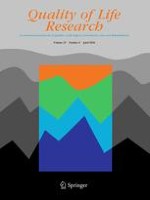01-04-2016
Mapping chronic liver disease questionnaire scores onto SF-6D utility values in patients with primary sclerosing cholangitis
Gepubliceerd in: Quality of Life Research | Uitgave 4/2016
Log in om toegang te krijgenAbstract
Purpose
The chronic liver disease questionnaire (CLDQ) is a frequently used liver-specific quality of life instrument, but it does not provide information on preference-adjusted health status, which is essential for cost-utility analysis. We aimed to develop a mapping function deriving utilities from the CLDQ in primary sclerosing cholangitis (PSC).
Methods
Short form-6D (SF-6D) utilities were calculated from SF-36 data collected in a recent prospective study in which unselected patients with PSC also completed the CLDQ. Ordinary least squares (OLS), generalized linear, median, and kernel regression analyses were employed to devise a mapping function predicting utilities. This was validated in three random subsamples of the cohort and in a separate sample of PSC patients following liver transplantation. Adjusted R
2 and root-mean-square error (RMSE) as well as Pearson’s r coefficients and mean absolute errors between predicted and observed values were used to determine model performance.
Results
Decompensated liver disease and fatigue, systemic symptoms, and emotional distress, assessed with the CLDQ, were related to worse SF-6D utilities. The final OLS prediction model explained 66.3 % of the variance in the derivation sample. Predicted and observed utilities were strongly correlated (r = 0.807, p < 0.001), but the mean absolute error (0.0604) and adjusted RMSE (10.6 %) were of intermediate size. Similar model characteristics were observed after employment of generalized linear and median regression models and at validation.
Conclusions
A model has been constructed, showing good validity predicting SF-6D utilities from CLDQ scores at the group level in PSC. Further testing is required to externally validate the model.
